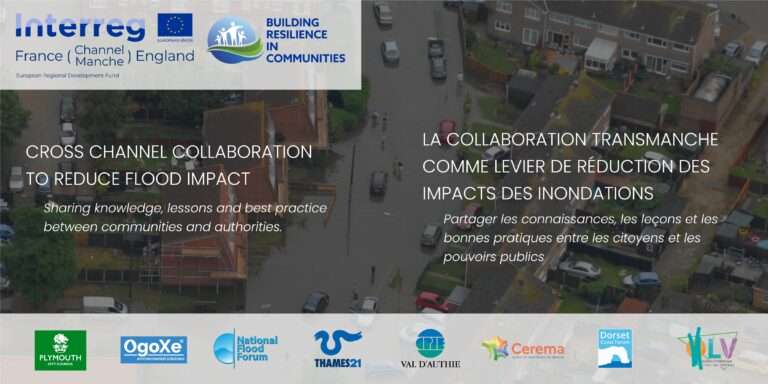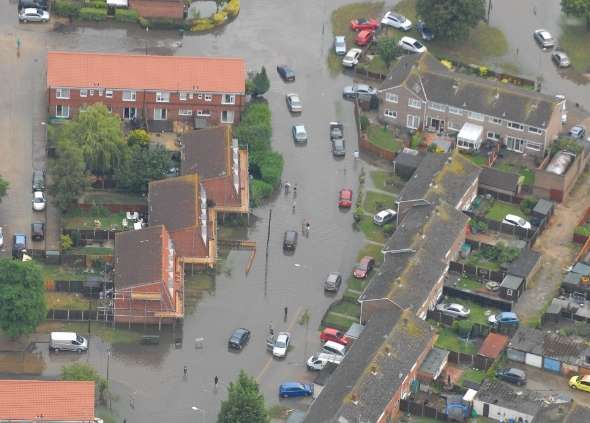BRIC Seminar/Workshop 24th Nov 2022
Cross Channel Collaboration to Reduce Flood Impact online event

Welcome to part 2/4 of this blog series, below we continue on from the end of part 1/4
In the next phase of the seminar, attendees were asked to log on to pre-created Jamboards with set questions that were designed to explore community views and provide a collection point for all the ideas of the day.
Translation services were not available on the Jamboards, so the English and French attendees populated different Jamboards. Results were shared afterwards, enabling cross-channel comparison of responses.
Attendees were split into English and French breakout rooms and given 35 minutes to write responses to question 1, after which they were invited to return to the seminar room to discuss the results. There were 3 questions in total on the day, which the attendees were asked via the Jamboards. These all directly followed on from the presentation topics provided by the speakers.
Room 1 & 2 (English speakers) were led by Lucy & Michael
Room 3 & 4 (French speakers) were led by Imane & Celine
Question 1 “Following on from the keynote speeches, what is currently happening in your area?”
How do communities and flood risk authorities communicate and operate? How is this sustained?
This does not have to be directly flood related, but concerns ways of communicating and organising successful groups, addressing ongoing issues (e.g. Neighbourhood Watch groups, River Action Groups) and agency-led responses (e.g. Emergency Flood Plans).
Below are the Q1 Jamboards and a summary of the answers given:


Events
- Community events
- Community driven events-held/devised/driven by flooded people to agendas they want to discuss in relation to flood risk and resilience
- Annual conference
- Novel engagement locations e.g. pubs, leisure centres, parks etc.
Meetings
- Through Community resilience meetings
- Frequency of meetings sustained
- Flood Action Group meetings
- Multi-Agency Meetings
- Attending Parish Council meeting and working with the communities.
Seminars and workshops
- Seminars and workshops
- Community-led mapping of flood risk assets and issues
Training
- Training
- Helping communities with their flood plan and training volunteer flood wardens.
Active listening
- Using community radio techniques to gather different perspectives from across our catchment area.
- Flooded people being listened to
- Appreciative Inquiry
- Face to Face Engagement
- Face to face, Newsletter and attending meetings
- Via online feedback form
Publicized information
- Using a shared online GIS workspace to present partners asset layers to provide a single overview of assets in the catchment. This is then ground truthed by site walkovers
- Communicating long term flood risk from climate change through visualization
- Using smart tech and community engagement.
- Newsletters
- Providing data to the community e.g. installation of river level sensing and making this information available online
- BRIC web platform
Establishment of groups and partnerships
- Working in partnership with our emergency organisations.
- Partnership working and collaboration between flooded people and Flood Risk Management Authorities
- Proactive partnership + community engagement
- Collaborative project between partners to create a integrate flood risk management approach on a catchment scale
- Involving community members / local flood groups in the steering group for FCRIP collaborative project
- Co-creation of flood risk projects between flooded people and Flood Risk Management Agencies
- Community Flood Group
- Local flood warden groups
- NFF groups
- Joined-up Thinking
- Working with communities to build resilience
- Regular communication between BRIC team and communities within our pilot areas
- Community Advisors appointed to give us different perspectives and local knowledge
- Multi-agency exercises for extreme weather events
- Beginnings of a flood resilience network
Community fund
- Setting up Community Fund to support local organisations and communities to try out new ideas around sustainability and flood mitigation
Warning systems
- Flood alert warning systems
Increased understanding
- Understanding of Climate Change
- Better understanding of flood risk issues within our areas because of information being shared by our communities
Pushes for change
- Flooded people pushing for change at a strategic level- changing the way flood risk is managed within their area
- Communities rejecting the traditional notion of resilience- ensuring the emphasis isn’t always on them to provide solutions to their flood risk issues
This blog series will return with part 3/4 on the 12th January 2023

Wow, fantastic blog structure! How lengthy have you ever been blogging for? you made running a blog look easy. The total look of your web site is excellent, as neatly as the content material!
Wow, incredible blog format! How lengthy have you been blogging for? you made blogging look easy. The entire look of your site is fantastic, let alone the content!
I just wanted to express my gratitude for the valuable insights you provide through your blog. Your expertise shines through in every word, and I’m grateful for the opportunity to learn from you.